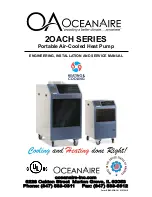
Chiller Controls Sequence of Operation
*The paragraphs below will outline the common sequence of operation for the MACH then expand into the operation sequence for both the water heating and water
chilling modes of operation. Following this information will be a section on system faults and problems solving.
The pump will not self-prime. A full column of liquid solution is necessary for proper operation. Do
not attempt to operate the pump without a full charge of liquid solution or seal damage will occur.
Common Sequence of Operation
When powered up the Multiaqua Heat Pump Chiller System energizes the control system transformer (208 - 240 volts),
creating 24 - volt control voltage.
First the pump bypass timer is energized and temporarily bypasses the flow switch energizing the pump relay. The
pump then starts to circulate move liquid solution through the piping system (
in a properly filled and air purged
system
)
.
The circulation o liquid solution from the pump discharge keeps the flow switch closed. After a 10
second delay the pump timer contact opens, connecting the flow switch in series with the high and low-pressure
switches. The pump will now run continuously unless power is interrupted or the flow switch opens.
*The only difference between heating and cooling modes is which coil is the evaporator and which coil is
condenser. Energizing or de-energizing the reversing valve solenoid accomplishes switching coils. See
reversing valve in Refrigerant Controls section.
The mechanical (heat/cool/off) switch selects the mode of operation for the Multiaqua Heat Pump Chiller. If the switch
selects off only the liquid solution pump will continue to operate. Turning the switch to heat utilizes the same sequence
described below but also energized the reversing valve and the Ranco
TM
DDL defrost control.
If the liquid solution temperature controller (DTC) is calling for cooling the control circuit is routed through the short
cycle timer, the three safety switches (the flow, low and high pressure switches), and through the Ranco
TM
DDL defrost
control to the compressor contractor. In heating the same sequence is followed with the exception, the 24-volt signal for
compressor operation is passed to and through the defrost control board, for compressor operation. once energized, the
contactor starts the compressor and condenser fan motors. The liquid solution controller (DTC) will open at the user
programmed set point, causing the refrigerant short cycle timer to open its contact for 5 minutes as it delays before
resetting to the closed position. This will de-energize the compressor and condenser fan motors. Power fluctuations will
also initiate a 5-minute time delay. The 5-minute time delay allows the refrigerant system a period for pressure
equalization, protecting the compressor from short cycling.
The chiller/heat pump temperature controller utilizes a thermistor to monitor the liquid solution temperature change. The
temperature is then compared to the set point and differential temperatures, programmed into the control by the user. The set
point is liquid solution temperature, which will cause the control to open. A cooling example would be control set point is
programmed at 44° LWT (leaving water temperature) with a 10° differential, which opens the controller at 44° LWT, and
closes it at 54°. A heating example would be the control programmed at 120° LWT with a 10° differential, which opens the
control at 120° and closes it at 110°. The differential temperature is the number of degrees above or below set point the
temperature programmed by the user into the controller. When liquid solution temperature falls or raises to the set
point the controller cycles the compressor off.
• See wiring diagram on page 9
Chillers are shipped with the digital temperature controller set at 44° LWT and a 10° differential for cooling; heating
is a 120° LWT and 10° differential.
21
Содержание MACH-060-1
Страница 12: ...11 ...
Страница 33: ...32 MACH060 01 Wiring Diagram 208 230 1 50 60 ...
Страница 34: ...33 MACH060 01 with Low Ambient Kit Wiring Diagram 208 230 1 50 60 ...













































